#aphroditos
Text

Aphroditos ⚥︎
#aphroditos#aphrodite#helpol#aphrodite deity#aphroditos deity#hellenic polytheism#polytheism#paganism#theoi#art#my art#personal#devotional artwork#do not repost pls !
173 notes
·
View notes
Text
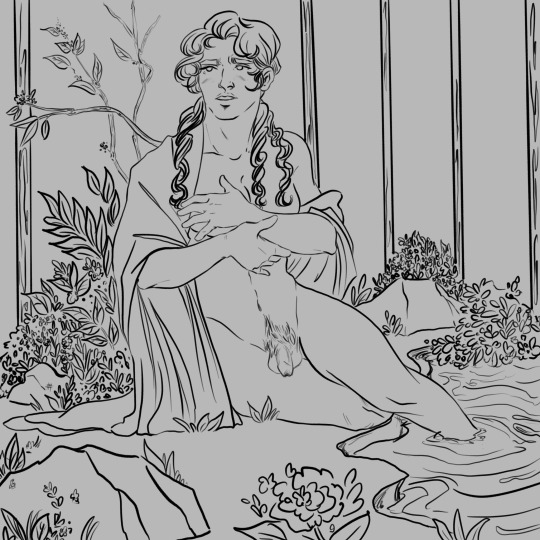
Aphroditos
204 notes
·
View notes
Text

This turned out better than expected
anyways I love Aphroditos and I would’ve drawn her sooner if I had any idea how to make it work without making her look like Aphrodite with a phallus (which I cannot draw at all). Primarily she has a beard and smaller boobs than i usually give Aphrodite. This design is meant for the iterations where Aphroditos is distinct from Hermaphroditos but not Aphrodite but also somewhat separate idk it makes sense in my mind on the extent of diffusion and mixing of divinities but I can’t put it into words.
#There’s also some Venus barbata thrown in bc yk#art#greek myths#greek mythology#traditional art#greek myth#mythology#greek gods#artwork#watercolours#watercolour#Illustration#aphroditus#aphroditos#aphrodite
7 notes
·
View notes
Text
Nonbinary Moon in Ancient Greek religion and magic
Despite being associated in Ancient Greek culture mostly with femininity, in some primary sources the Moon and lunar deities are depicted as female and male at once. The Orphic Hymn to Selene describes the Moon Herself thus:
Female and Male with borrow’d rays you shine, and now full-orb’d, now tending to decline.
Mother of ages, fruit-producing Moon [Mene], whose amber orb makes Night’s reflected noon
(trans. Thomas Taylor)
Androgyny is a common theme in Orphicism, whether for deities such as Phanes - for whom being both male and female is one of the main attributes - or those usually depicted as one, binary gender. However, the nonbinary lunar doesn’t end with Orphicism.

[picture: a relief of Selene]
If you’ve been at least lurking in Hellenic Pagan side of Tumblr, you have possibly already learnt about Aphroditus, who became sort of trans icon here. What you might not know is that he was a lunar deity as well. The Roman writer Macrobius, who identifies her with Venus, describes him thus in Saturnalia:
There’s also a statue of Venus on Cyprus, that’s bearded, shaped and dressed like a woman, with scepter and male genitals, and they conceive her as both male and female. Aristophanes calls her Aphroditus, and Laevius says: Worshiping, then, the nurturing god Venus, whether she is male or female, just as the Moon is a nurturing goddess. In his Atthis Philochorus, too, states that she is the Moon and that men sacrifice to her in women’s dress, women in men’s, because she is held to be both male and female.
At last, the nonbinary Moon can be found in Greek Magical Papyri as well. The fragment below comes from a spell calling upon a syncretic goddess identified with Hekate, Selene and many others.
I call you, triple-faced goddess
Mene, O light-beloved
Hermes / and Hekate at once
Male-female child together
- PGM IV. 2608-2611
The word Mene means the same as Selene - the Moon, and was often used as an alternate name for the goddess. Possibly this fragment - syncretizing Hermes and Hekate, two closely connected but almost never equated deities - can be also linked to the mysterious Hermekate appearing elsewhere in the PGM.
Those are examples I know - if any of you know more, I’d love to hear about it. What we can see even now is that the nonbinary lunar, despite the obscurity, was a recurring motif that could appear in very different traditions of Ancient Greece.
#selene#hermes#hekate#aphroditos#aphroditus#mene#hellenic deities#hellenic paganism#hellenic polytheism#ancient greek magic#queer#lunar deities#czortposting
138 notes
·
View notes
Text
“Among the numerous Cypriot sanctuaries of the goddess (Aphrodite), that at Amathous, where the population was of indigenous and Phoenician stock, was noted for its unusual, bi-gendered deity. Here the image of the goddess wore female garb, but was bearded and held a scepter. The locals called this deity Aphroditos, a name that was also known in fifth-century Athens. The androgyny of Aphrodite at Amathous again points to the Near East, for Phoenician Astarte is likewise known to have had a male aspect, but it is also compatible with Greek ideas of Aphrodite as the goddess born of Ouranos’ genitals, who governed male sexuality.”
- Ancient Greek Cults: A Guide by Jennifer Larson
6 notes
·
View notes
Text
To all Hellenists who own those statue reproductions that are all aesthetic and white and museum looking: I dare you to paint them
#hellenism#it's historical!#they're too CLEAN#am I just buttmad that I can't buy an Aphroditos Anasyromenos? yes
3 notes
·
View notes
Text
"There's also a statue on Cyprus that's bearded, shaped and dressed like a woman, with a scepter and male genitals, and they conceive her as both male and female. Aristophanes called her Aphroditos, and Laevius says: "Worshipping, then, the nurturing god Venus, whether she is female or male, just as the Night-Shiner is a nurturing goddess." In his Atthis Philochorus, too, states that she is also the moon and that men sacrifice to her in women's dress, women in men's, because she is held to be male and female."
— Saturnalia: Books 3-5, Volume 2, by Ambrosius Aurelius Theodosius Macrobius, edited and translated by Robert A. Kaster
672 notes
·
View notes
Text
There are some animals that, if they didn't exist and somebody made them up, we would say they had an overactive imagination. The bobbit worm is one of those creatures, the closest we have to a real-life Mongolian death worm. So for this Wet Beast Wednesday, I'll tell you about just how weird it is.
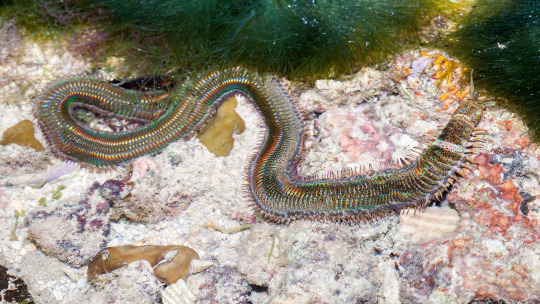
(image: a rare full-body shot of a bobbit worm)
Before we start, I want to go on a brief tangent. What exactly is a worm? Well it turns out that like fish, worms aren't real. At least they aren't from a taxonomist's perspective. In common parlance, we refer to any long, skinny, and (usually) legless invertebrate as a worm. In taxonomy, that is far too broad of a category, especially as lots of animal lineages would have started out as something a lot like a worm and you can't stop being what your evolutionary ancestors were. Instead, taxonomists classify worms into multiple distinct phyla that independently converged onto the worm body plan, including the platyhelminths, nematodes, nemerteans, and annelids. The bobbit worm (Eunice aphroditos) is an annelid, which are known for their multiple body segments. More specifically, it is a polychaete or bristle worm, which are known for having a pair of fleshy protrusions called parapodia on each body segment, which have chitinous bristles called chaetae growing from them. There is some debate that the bobbit worm may actually be a species complex, which is when multiple related species are mistakenly classified as a single species.
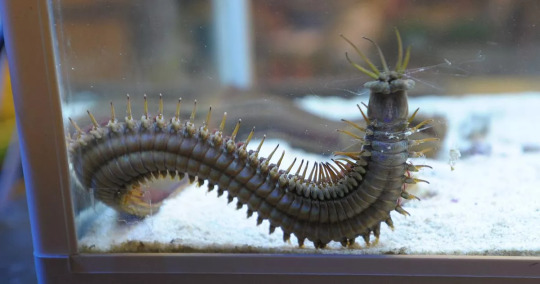
(image: a bobbit worm found in an aquarium)
Bobbit worms are the largest of the polychaetes, with the largest known specimen being 299 cm (9.81 ft) long. They are also rather skinny, usually reaching no more than 2.5 cm (1 in) wide. Bobbit worms have a wide range of coloration, ranging from brown to black and often with a rainbow of other colors going down their bodies. You might not notice this, however, because they spend most of their time burrowing under the sand in their Indo-Pacific coral reef habitats. This provides protection from predators and is important to their hunting strategy. Bobbit worms will stick their heads out of the sand and wait while their 5 antennae use chemosensitive and light-sensing cells to detect when fish pass by. When a fish comes too close, the worm strikes. They use a set of retractable jaws that are razor sharp and come together like scissors to bite the fish. This bit is strong enough to cut small fish in half. It is rumored that this is the source of their name, from the Lorena Bobbit case. I will not elaborate further, google it if you don't know. Those fish that are not killed immediately will find themselves bleeding out and paralyzed from venom injected through the jaws as they are dragged into the worm's burrow to be eaten. There are some reports that the wom's chaetae are also venomous and that handling them barehanded can cause permenent numbness, but this does not appear to be the scientific consensus. The worms will also feed on seaweed and other algae, making them omnivorous.
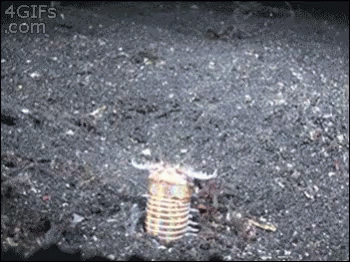
(gif: a bobbit worm catching a fish)
The borrows made by bobbit worms are dug out of the sediment and coated with mucus. The worm uses its chaetae to move in and out of the burrow. The mucus if filled with nutrients that bacteria, particularly sulfate-reducing bacteria, absolutely love. This allows iron sulfides to accumulate in the mucus. When exposed to oxygen in the water, usually at the opening of the burrow, the sulfides will become iron hydroxides. These help reinforce the burrow's opening. Bobbit worms rarely leave their burrows and will retreat at the first sign of danger, making it very hard to spot them in the wild. Several fossilized burrows have been found, one dating to 20 million years ago. Another burrow of a similar animal, possibly an ancient relative of the bobbits, was found dating to 400 millions years ago.
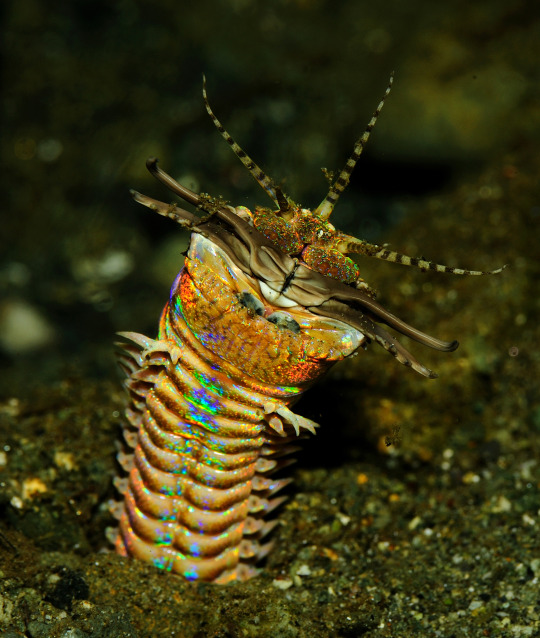
(image: a bobbit worm head with jaws extended)
Bobbit worms reproduce externally. At night, a female will emerge from her burrow and release pheromones that attract males. She will then release her eggs into the water. The males will follow by releasing sperm, allowing for fertilizations. The majority of larvae will die before reaching adulthood. There are rumors that females withh bite off the male's genitals to feed to her young, but this is not true. Bobbit worms can also reproduce asexually by splitting. When handles, a bobbit worm can split itself into multiple sections, each of which can grow into another identical worm. This is a common adaptation in polychaetes as it allows them to survive if a part of them is eaten.
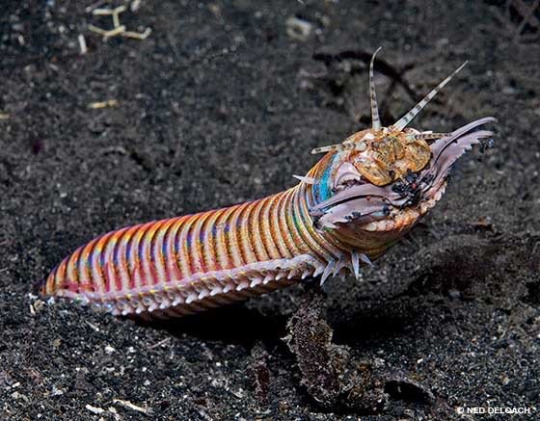
(image: a bobbit worm just sitting there, menacingly)
Bobbit worms have become a nuisance species in aquariums. They are usually introduced as tiny larvae clinging to rocks brought in for decoration or shelter. Once in an aquarium, the worms can grow rapidly and will eat any fish in the tank. Removing them can be very difficult due to their size, regenerative abilities, and reclusive nature. One famous case that introduced a lot of the internet to the worms was that of the Newquay aquarium in England. Aquarium staff were confused when a lot of the fish were vanishing from one tank and the coral was damaged. They tried laying traps, but the intruder ate the fishhooks they used and could bite through 20 lb fishing line. Finally, they lured it out with food, finding a 4 foot long bobbit worm that they named Barry. Barry became a hit online and was moved to his own tank. There apparently were plans to put him on exhibit, but I can't find confirmation that this ever happened. Given that this happened in 2009 and the bobbit worm lifespan is 3-5 years, I am sorry to tell you that Barry has passed away. RIP, king.
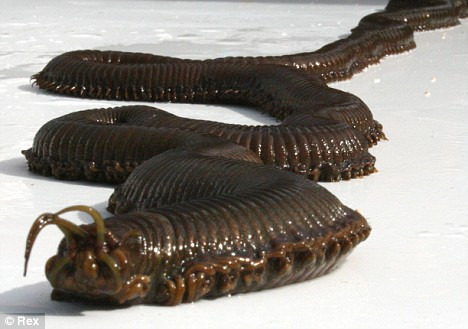
(image: Barry after being removed from the tank. His drab color is thought to be the result of poor nutrition)
Because of how reclusive they are, bobbit worms are an understudied species. Attempts to raise them in laboratories have mostly failed, so there is a lot we don't know about their reproduction, development, and behavior. We also don't know if they need any conservation efforts.
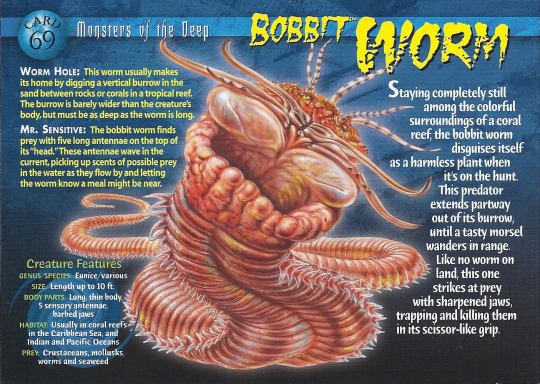
How many times in this series am I going to be able to use cards from this series? (image: the bobbit worm card from Weird n' Wild Creatures)
#wet beast wednesday#marine biology#biology#zoology#bobbit worm#animal facts#worm#annelids#polychaete#images#barry the bobbit worm#late again#forgot to prep a post
354 notes
·
View notes
Text
⚧️ The Gods & Gender ⚧️
Discussing Trans-Exclusive Radical Feminism and the views of the Gods is not "speaking for the Gods,"—it is looking at facts and information and drawing completely reasonable conclusions that squarely put the foundations of trans-exclusion in opposition to the Gods.
(definitely not audio proof read, sorry for the dyslexia)
🌿Aphrodite & Venus🌿
Aphroditos (or Aphroditus) is Aphrodite with male characteristics including a penis and/or beard.
A cult of Aphrodite included a bearded Aphrodite at Amathus, Cyprus on a high cliff temple. [Wikipedia citing Macrobius, Saturnalia III]
Her relationship with bisexuality (referring to being dual sex not sexual orientation in this paper), androgyny, and transvestism is also documented in Cyprus:
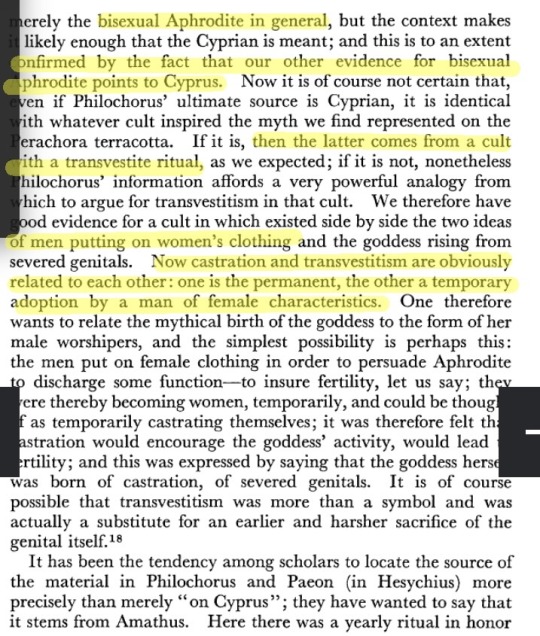
— Aphrodite in the Theogony by William Sale in Transactions and Proceedings of the American Philological Association Vol. 92 X
(Sorry for the shitty screenshot JSTOR did not want to work with me)
This worship of Aphrodite with a penis was also seen as equal to Venus:
There's also a statue of Venus on Cyprus, that's bearded, shaped and dressed like a woman, with scepter and male genitals, and they conceive her as both male and female. Aristophanes calls her Aphroditus, and Laevius says: Worshiping, then, the nurturing god Venus, whether she is male or female, just as the Moon is a nurturing goddess. In his Atthis Philochorus, too, states that she is the Moon and that men sacrifice to her in women's dress, women in men's, because she is held to be both male and female." — Macrobius (c. 400s AD), Saturnalia 3.8.2
🌿Hermaphroditus🌿
There is also the "intersex child of Aphrodite & Hermes" named Hermaphroditus.
I have seen many use Hermaphtoditus as an excuse to wipe away the Goddess Aphrodite with a penis that the ancients worshipped. Which doesn't even make sense because I hate to break it to you— Hemaphroditus also opposes TERF ideology by its nature. A God existing as bisexed/dual-sex/bigender (however you'd like to word it) negates the idea that the Gods somehow support the ridged biological essentialism and gender binary that TERF ideology necessitates.
There are different accounts of Hermaphtoditus' creation but one, Ovids, tells of him merging with a nymph and then asking his parents to make the water transformative causing men to have thr effeminate bodies like women:
Her prayer found gods to hear; both bodies merged in one, both blended in one form and face. As when a gardener sets a graft and sees growth seal the join and both mature together, thus, when in the fast embrace their limbs were knit, they two were two no more, nor man, nor woman--one body then that neither seemed and both. So when he saw the waters of the pool, where he had dived a man, had rendered him half woman and his limbs now weak and soft, raising his hands, Hermaphroditus cried, his voice unmanned, ‘Dear father [Hermes] and dear mother [Aphrodite], both of whose names I bear, grant me, your child, that whoso in these waters bathes a man emerge half woman, weakened instantly.’ Both parents hears; both, moved to gratify their bi-sexed son, his purpose to ensure, drugged the bright water with that power impure." — Ovid, Metamorphoses 4. 28 ff (trans. Melville) (Roman epic C1st B.C. to C1st A.D.)
🌿More on Aphroditos vs Hermaphroditus read @theoi-crow's excellent post about them here.
Also some lovely statues:
Marble copy statue from a fresco at Herculaneum, Italy. X (left)
Statue from Pergamum, Turkey. X (center)
Statue from Nymph Sanctuary in Lacori, Italy X (right)
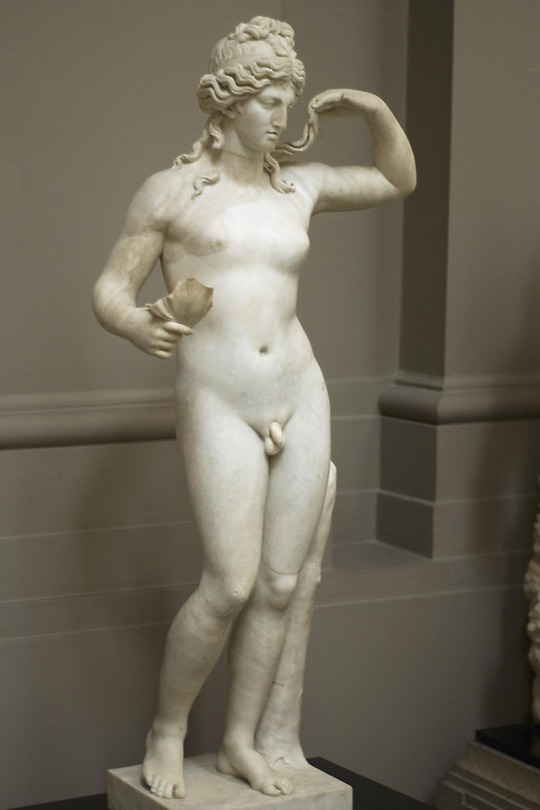
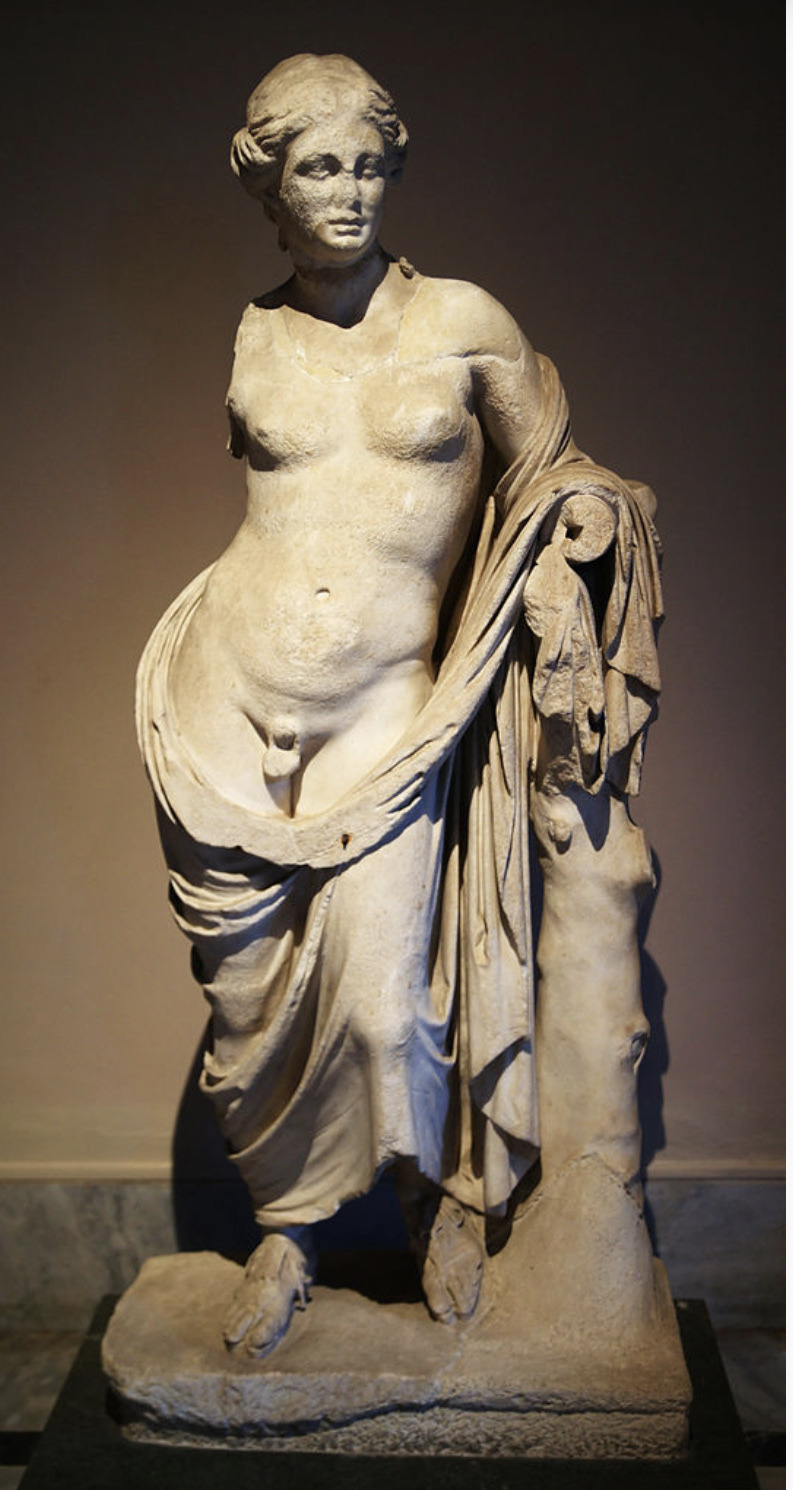
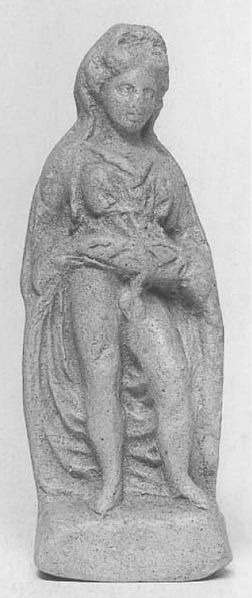
Statue from Pompeii, Italy X

🌿Inana & Ishtar🌿
From a hymn to Inana
To open up roads and paths, a place of peace for the journey, a companion for the weak, are yours, Inana. To keep paths and ways in good order, to shatter earth and to make it firm are yours, Inana. To destroy, to build up, to tear out and to settle are yours, Inana. To turn a man into a woman and a woman into a man are yours, Inana. Desirability and arousal, goods and property are yours, Inana. Gain, profit, great wealth and greater wealth are yours, Inana. Gaining wealth and having success in wealth, financial loss and reduced wealth are yours, Inana. Observation (1 ms. has instead: Everything), choice, offering, inspection and approval are yours, Inana. Assigning virility, dignity, guardian angels, protective deities and cult centres are yours, Inana. — A Hymn to Inana (Inana-C) ETCSL 4.07.3 in Lines 115-131.
This shows:
Inana has the power to change a person's gender/sex .... which means people can change gender/sex
This is listed among other normal things such as journeys, wealth, settlements so on. Suggesting that it wasn't super special, it was a part of Sumerian society that Inana was given power over.
This was written by Enheduanna High Priestess of Nanna, Ur's city God, and Inana. Inana was a popular Sumerian deity and Enhenduanna's father, Sargon of Akkad's, personal deity was Ištar. One of Enhenduanna's goals as a priestess was to conflate the popular Sumerian deity Inana with her father's Akkadian personal Goddess Ištar. Then raise Inana (and thus her father's personal Goddess Ištar) to an extremely high place in cosmology and explain just how much control she had in society— including over sex/gender.
Also from @sisterofiris's post on Inana's queer priests here.
🌿Nanaya🌿
In later times Inana/Ištar was equated with Nanaya but in earlier times they were worshipped side by side as separate deities. While Inana's hymn gives her rule of gender, a Nanaya hymn has her directly declaring she has breasts in Dadumu and a beard in Babylon. Leick also mentions here that Ištar was worshipped in both genders.

—Dictionary of Ancient Near Eastern Mythology by Gwendolyn Leick. Page 125.
🌿Asūšunamir with Ereškigal🌿
In Ištar's Descent (not Inana's) Ea's plan to distract Ereškigal and get her to bring Inana back to life is to make a beautiful being. Ea makes an incredibly beautifully brilliant being that's mere aesthetic presence will make Ereškigal happy and let her defenses down. And Asūšunamir's beauty works..... and he is an eunuch, an effeminate male, potentially queer from the ancient's eyes. And yet he is so beautiful he distracts a Goddess.

— The Ancient Near East and Anyhology of Texts and Pictures, edited by Pritchard. Ishtar Descent translation by E.A Speiser. Page 80.
🌿Eštan / Ištanu🌿
The Anatolians (Hittite in particular) loved to both mix deities and keep them entirely dependent like 8 solar deities and 50 storm Gods. But sometimes Hittite, Hurrian, Hattic, Indo-European, Mesopotamian all meld together making the identification of gender ambiguous or even interchangeable.
Eštan is one example (who has numerous equatings):

—A Handbook of Gods and Goddesses of The Ancient Near East by Frayne & Stuckey. Page 105
You can also learn more about the Ištanu and the Sun Goddess of Arinna and her gender from @sisterofiris in a post here.
__
I'm sure there are more! But this was my quick round up and sources I could put together. To all the trans & non-binary polytheists out there, you aren't abnormal and the Gods see you for who you truly are.
Edit: Want some more? Learn about the feminine qualities of Apollo
#polytheism#paganism#helpol#lgbtq#hellenic polytheism#mesopotamian#disc horse#lgbt+#queer#landof2rivers#ofthetheoi
454 notes
·
View notes
Note
this may seem like a weird question, and if this comes across as disrespectful i apologize. but, could lady aphrodite be - well - a man? could they appear to a devotee of theirs as male instead of female? i know spirits' appearances are fluid and change depending on who, when, where, what, and so on, but, is it possible that they ever change their gender? i've never seen anybody mention it, and, aphrodite doesn't feel female to me, instead they feel as a gender-reversed version of themself.

DID YOU MEAN APHRODITUS ?!
Lol I love this topic. Yes! You are not confused in feeling a male or masculine energy in Aphrodite. There’s a LOT of really cool history that goes into the archetype of the God(dess) of Venus and love and war, but to make a very long story short, Aphroditus (or Aphroditos) was the male Aphrodite originating from Amathus on the island of Cyprus and celebrated in Athens. He was later then syncretized with the offspring of Aphrodite and Hermes, Hemaphroditus. Different interpretations may or may not consider them to be the exact same entity. What we do know is that both Aphroditus and Hermaphroditus are always portrayed with an androgynous, intersex, or transsexual body, a mix of female and masculine traits and anatomy.
It’s widely accepted that Aphrodite/ Aphroditus is derived from the Mesopotamian Goddess Inanna/Ishtar. Inanna is a very important deity in regards to gender and sexuality, as she was the Goddess known to transform men into women and women into men. She was the patron of transgendered, intersex, and nonbinary people, and her holy priests and priestesses were very queer! She was portrayed with a beard, breasts, basically whatever she wanted lol, as she was believed to be the origin of queerness itself. All bodies, male, female, or something in between, are capable of exercising the joy of Inanna!
In general, the energy that we receive from Venus has always seemed to be inherently queer, gender bending, and fluid, which makes sense for the planet of love- love for others as well as love for the self! It transcends our traditional understanding of gender and sex and shows us how all of these identities are beautiful and powerful.
People often associate Aphrodite very highly with females vagina power, which she totally does embody to the max of course, but she also very much represents love for the self that transcends the flesh. She has always been the biggest ally to transmascs and femmes. In some interpretations, the God(dess) may be trans and queer themselves.
As a trans man myself, I personally view Lord Lucifer as an Aphroditus, the beautiful son of an Aphrodite. The divine masculine aspect of Venus that exists within the divine feminine. Combined with his values of self love, luxury, freedom, knowledge, and the courage to be your most authentic self, I see Lucifer, Aphroditus and Aphrodite as the pillars of queer divinity.
#witchcraft#magick#occultism#pagan#demonology#paganism#witch community#witch aesthetic#witchblr#grimoire#queer community#queer#inanna#aphrodite deity#aphrodite#aphroditus#lucifer deity#luciferian witch#deity witchcraft#deity#deity work
37 notes
·
View notes
Text
happy trans day of visibility lovelies !!! may Aphrodite bless your days, for the Goddess Herself is trans and delights in the trans experience. She is Golden-Crowned Aphroditos, fierce mother and the protector of Her trans children. you are beautiful to Her just as She is beautiful to us
Aphrodite has blessed us with unique gender experiences, delight and rejoice !!! 🌺🌿🕊️
#aphrodite#helpol#aphrodite deity#aphroditos#hellenic polytheism#aphrodite worship#hellenic pagan#aphrodite goddess#lgbtq#greek gods#theoi
168 notes
·
View notes
Note
it’s Aphroditos not Aphrodite they’re different mythological figures (unless autocorrect just got you when you were typing her name 🤷♂️ :3)
Didn’t even notice. Hope I didn’t offend the gods
36 notes
·
View notes
Text

Why is coming up with separate drafts so stressful?
#This is aphroditos btw#Because I love her (but was unable to design for her on account of “cannot visualize penis”)#wip#sketches#art#aphroditus
0 notes
Text

Hello to all ⭒
My name is Vasileios, but some nicknames of mine are: Vasil, Elios, Silo, & Vrincey.
I am a transgender male, I go by he/him &/or them/they, and I am underneath the AroAce umbrella.
I dabble in writing devotional poetry for my deities every once in a while, I believe poetry is one of the very scarce yet beautiful ways I can show my love to my deities, and love itself, is a poem in my eyes.
I practice witchcraft and believe religiously in pantheism + polytheism. I work with ranging pantheons, including angelics and infernals.
My craft is a potion mixture of many things, and I mainly enjoy to simply go with whatever makes me feel the happiest and safest within. To put some sort of label on it, you could consider me eclectic and someone who works with chaos magic(k).
I am closest to the deities: King Asmodeus, Prince Apollon, Mother Hekate, Highness Aphrodite/Aphroditos, Grand Duke Dionysus, King Yeshua, Lord Hypnos, King Loki, Noblewoman Psyche, Lord Eros, Lord Satanas, King Lucifer, and Madame Pelé. With the honorable mentions of my spirit guide, Xinoth, and my higher self in all of their fluidity and infinite forms.
I occasionally work with archangels Uriel and Chamuel, Venus, and some unnamed other entities.
Asks and messages are open for anyone as long as you are respectful, kind, and in general a more-so decent person. I am always looking forward to conversations about spirituality, crafts, or anything in between.
I do not condone any sort of discrimination, this is in no way a safe place for:
Anti-LGBTQIA+
Racist/Xenophobia
Proselytizing
Any sort of pedophilia
Religious discrimination
I do not know every single thing down to its very detail, but I am more than happy to help any beginners or people considering diving into the practices!
Where I got my dividers: @saradika
This page is mainly for E-Offerings to (my) deities, sharing UPG, and hopefully to help someone in need.

17 notes
·
View notes
Note
hello dear! i currently am devoted to Lady Aphrodite and am interested in learning more about Dionysus. i love your blog, and I see you work with both- whats your experience with both of them? individually as well as together. do you have tips on working with them? sending love your way! thanks <3
why hello lovely ! thank you for asking, I love talking about Aphrodite and Dionysos. They have truly been my rocks for several years and I really wouldn't be who I am today had I not had Them.
Aphrodite and I have a very fluid relationship. She is my favorite neighbor, the elderly woman who loves to sing me songs, the gentle mother i longed for, my lover, my soother, my tear-soaked shoulder, my laughter, and everything in between. She was the majority of my emotional support through extremely hard times and She carries Herself with a softness I've always trusted.
theologically, i attribute Aphrodite to all earthly creation and the love that persists in the universe. while i view Deities like Gaia as personifications of earthling life, I see Aphrodite as the force that compels life. i heavily associate Her with the physical/material world, especially the physical connections we can form with the world and beings around us. this is why i worship Her as Aphrodite and Aphroditos, because I view the body as the thing that connects humanity to every other physical thing. She was born from the mixing of the sea, earthly blood, and divinity representing the harmony of creation. I also see Her in the unique things we can only do because of our physical body. this includes feeling complex emotion, sensuality, sexuality, gender identity, self expression, and more. Aphrodite taught me to love and express myself wholeheartedly, and extend that love to every other living thing.
Dionysos, on the other hand, is the blessing of consciousness. Dionysos is the reason we can appreciate and love the things the other Theoi gift and cultivate. He was the one who kisses our eyes and liberates us from automation. I speak about my views of Him in this post here which explain it well i think. Dionysos came to me when i was young, reckless, and naive. contrary to many of the others i found who worship Him, He brought a serious and structured breath to my lungs. if He had been anywhere close to the rambunctious and indulgent God many people know Him as, i would have flown off the tracks and destroyed my life. He came to me as a God of moderation, balance, and self-realization. I don't often see His carefree or festivity-oriented aspects.
Their roles in my life have drifted apart as time has gone on. when I was younger there was a lot more collaboration and syncretism of Dionysus and Aphrodite in my worship. these days, things are quite separate on the surface. They seem to have a very close relationship in my life in a way I find hard to put into words. Aphrodite definitely brings an airy, relaxed perspective while Dionysos is able to navigate any chaos that arises with grace. They keep the balance between logic and emotion in check, though there is no clean divide between who is which. i wish I could describe it better for you, but English is so limiting. I'll put it this way: I have never seen Their roles in my life as separate nor conjoined, but it feels wrong to worship Them in different shrines. I don't speak about my devotion without speaking both of Their names and I credit Them equally for the man I am right now.
the tips I have for you are scarce. Aphrodite and Dionysos both handle domains that are extremely unique to each individual, so it is hard to give advice when all i know is my own inner world. I would say that the best way to approach both of Their influences is without expectation or method. letting the lessons be fluid and appear as they are meant to has been most effective. my worship with Them has also been very non-linear so i wouldn't be concerned if one of Them drops off for a little, or if the dynamics shift frequently. Aphrodite and Dio flow together in a very unique way, which can be difficult to get used to in the beginning. but again, this is just my experience. i hope it helps a little ! and good luck <3
#dionysos#dionysus#aphrodite#personal#upg#helpol#asks#anon#greek gods#theoi#hellenic polytheism#polytheism#paganism#syncretism
31 notes
·
View notes
Text
hello loves 💕✨
you can call me lunare, and i'm new to tumblr and this whole space! i have, in the past, been a lurker on some pagan/polytheist tumblr blogs, but i tried recently to lurk and was struck with a huge popup that i needed to create an account
and so i've been forced to no longer fully lurk and i decided to make an active blog here 💕
that being said! please interact with this post if you're a hellenic or roman polytheist blog! any deity focus is encouraged, though if it's important, i feel a close connection to aphroditos and venus particularly ✨
also: i'm 17 years old! i'm fine with anyone interacting, but keep in mind i'm a minor!!
9 notes
·
View notes